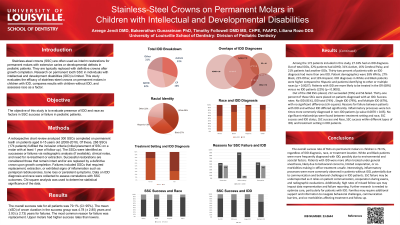Special Health Care Needs
Efficacy of Stainless-Steel Crowns on Permanent Molars in Children with Intellectual and Developmental Disabilities
133 - Stainless-Steel Crowns on Permanent Molars in Children with Intellectual and Developmental Disabilities


Areege Jendi, DMD
Resident
University of Louisville School of Dentistry
University of Louisville School of Dentistry
Louisville, Kentucky, United States
Liliana Rozo Gaeth, DDS,Ms,CHPE
Clinical Associate Professor
University of Louisville
Louisville, Kentucky, United States- TF
Timothy B. Followell, DMD,MS (he/him/his)
Assistant Professor
University of Louisville
University of Louisville School of Dentistry
Louisville, Kentucky, United States
Presenting Author(s)
Research Mentor(s)
Program Director(s)
Purpose: Stainless-steel crowns (SSC) are often used as interim restorations for permanent molars with extensive caries or developmental defects in pediatric patients. They are typically replaced with definitive crowns after growth completion. Research on permanent tooth SSC in individuals with intellectual and development disabilities (IDD) is limited. This study evaluates the efficacy of stainless-steel crowns on permanent molars in children with IDD, compares results with children without IDD, and assesses race as a factor.
Methods: A retrospective chart review analyzed 300 SSCs completed on permanent teeth on patients aged 6-15 years old (2008-2018). Of these, 268 SSCs (174 patients) fulfilled the inclusion criteria (initial placement of SSC on a molar with at least 1 year of follow up). Successful restorations are considered those that remain intact and/or are replaced by a definitive crown upon growth completion. Failures included replacement, extraction, or signs of inflammation. Data on IDD diagnosis and race were collected to assess correlations with SSC outcomes. Chi-square analysis was used to determine statistical significance of the data.
Results: The overall success rate for all patients was 79.1% (CI: 95%). The mean(SD) of crown duration in the success group was 4.78(2.85)years and 3.93(2.73) years for failures. The most common reason for failure was replacement. Upper molars had higher success rates than lowers. Among the 172 patients included in this study, 27.33% had an IDD diagnosis. Out of total IDDs, 32% patients had ADHD, 31% Autism, 16% Cerebral Palsy, and 21% patients had another IDDs. Thirty-two percent of patients with an IDD diagnosis had more than one IDD. Patient demographics were 38% White, 27% Black, 22% Other, and 13% Hispanic. IDD diagnoses in White and Black patients were higher compared to Hispanic and patients identifying to other or multiple races (p = 0.0027). Patients with IDD are more likely to be treated in the OR (68%) versus no IDD patients (22%) (p < 0.0001).
Out of the 268 SSCs placed, 212 succeeded (79%) and 56 failed. Thirty-one percent of these SSCs were placed on patients diagnosed with an IDD. Success rates: No IDD (81%), IDD total (74%) , Single IDD (79%), and Multiple IDD (67%), with no significant difference (chi-square). Reasons for failure between patients with IDD and without IDD differed significantly. Inflammatory process were ten times more commonly diagnosed in non-IDD patients (p-value 0.0070 < 0.05).
No significant relationships were found between treatment setting and race, SSC success and IDD status, SSC success and Race, SSC success within different types of IDD, and treatment setting in IDD patients.
Conclusions: The overall success rate of SSCs on permanent molars in children is 79.1%, regardless of IDD diagnosis, race, or treatment location. White and Black patients were more frequently diagnosed with IDD, possibly due to environmental and societal factors. Patients with IDD were more often treated under general anesthesia, likely due to behavioral concerns, limited cooperation, or co-morbidities making in-office treatment unsafe. Interestingly, inflammatory processes were more commonly observed in patients without IDD, potentially due to communication and behavioral challenges in IDD patients. SSC failure may be underreported as it relies on patient communication, cooperation during exams, and radiographic evaluations. Additionally, high rates of missed follow-ups may impact data representation and failure reporting. Further research is needed to optimize care, particularly for patients with IDD. Families may require additional support and information to navigate behavioral challenges, communication barriers, and co-morbidities affecting treatment and follow-up.
Identify Supporting Agency and Grant Number:

.jpg)